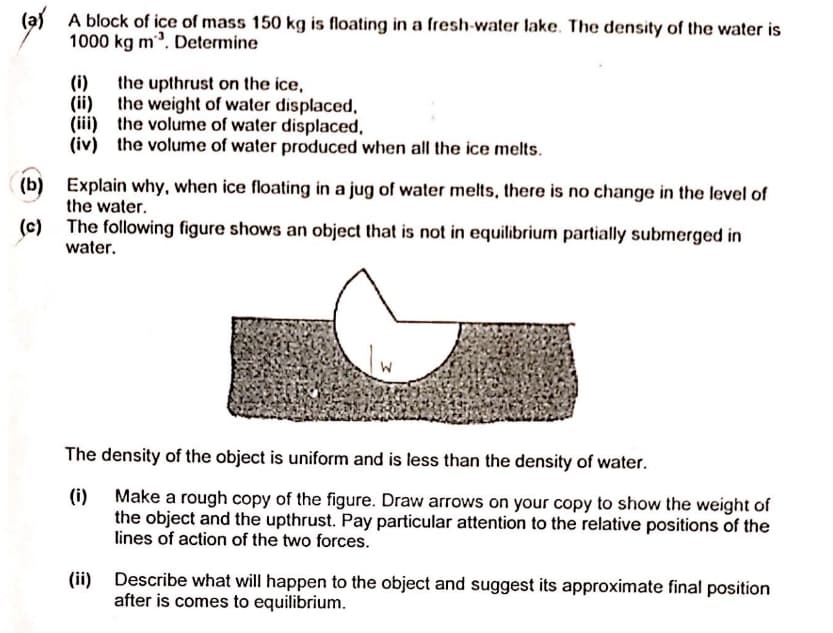(a) A block of ice of mass 150 kg is floating in a fresh-water lake. The density of the water is 1000 kg m. Determine (i) the upthrust on the ice, (ii) the weight of water displaced, (iii) the volume of water displaced,
(a) A block of ice of mass 150 kg is floating in a fresh-water lake. The density of the water is 1000 kg m. Determine (i) the upthrust on the ice, (ii) the weight of water displaced, (iii) the volume of water displaced,
University Physics Volume 1
18th Edition
ISBN:9781938168277
Author:William Moebs, Samuel J. Ling, Jeff Sanny
Publisher:William Moebs, Samuel J. Ling, Jeff Sanny
Chapter14: Fluid Mechanics
Section: Chapter Questions
Problem 129CP: Fluid originally flows through a tube at a rate of 100 cm3/s. To illustrate the sensitivity of flow...
Related questions
Question
Full solution pls (Ans: ai) 1470N, aii)1470N, aiii)0.15m3, aiv)0.15m3)

Transcribed Image Text:(a) A block of ice of mass 150 kg is floating in a fresh-water lake. The density of the water is
1000 kg m. Determine
(i)
the upthrust on the ice,
(ii)
the weight of water displaced,
(iii) the volume of water displaced,
(iv) the volume of water produced when all the ice melts.
(b) Explain why, when ice floating in a jug of water melts, there is no change in the level of
the water.
(c)
The following figure shows an object that is not in equilibrium partially submerged in
water.
The density of the object is uniform and is less than the density of water.
(i) Make a rough copy of the figure. Draw arrows on your copy to show the weight of
the object and the upthrust. Pay particular attention to the relative positions of the
lines of action of the two forces.
(ii)
Describe what will happen to the object and suggest its approximate final position
after is comes to equilibrium.
Expert Solution
This question has been solved!
Explore an expertly crafted, step-by-step solution for a thorough understanding of key concepts.
This is a popular solution!
Trending now
This is a popular solution!
Step by step
Solved in 4 steps

Knowledge Booster
Learn more about
Need a deep-dive on the concept behind this application? Look no further. Learn more about this topic, physics and related others by exploring similar questions and additional content below.Recommended textbooks for you

University Physics Volume 1
Physics
ISBN:
9781938168277
Author:
William Moebs, Samuel J. Ling, Jeff Sanny
Publisher:
OpenStax - Rice University

College Physics
Physics
ISBN:
9781305952300
Author:
Raymond A. Serway, Chris Vuille
Publisher:
Cengage Learning

Principles of Physics: A Calculus-Based Text
Physics
ISBN:
9781133104261
Author:
Raymond A. Serway, John W. Jewett
Publisher:
Cengage Learning

University Physics Volume 1
Physics
ISBN:
9781938168277
Author:
William Moebs, Samuel J. Ling, Jeff Sanny
Publisher:
OpenStax - Rice University

College Physics
Physics
ISBN:
9781305952300
Author:
Raymond A. Serway, Chris Vuille
Publisher:
Cengage Learning

Principles of Physics: A Calculus-Based Text
Physics
ISBN:
9781133104261
Author:
Raymond A. Serway, John W. Jewett
Publisher:
Cengage Learning

Physics for Scientists and Engineers, Technology …
Physics
ISBN:
9781305116399
Author:
Raymond A. Serway, John W. Jewett
Publisher:
Cengage Learning

College Physics
Physics
ISBN:
9781285737027
Author:
Raymond A. Serway, Chris Vuille
Publisher:
Cengage Learning

Physics for Scientists and Engineers with Modern …
Physics
ISBN:
9781337553292
Author:
Raymond A. Serway, John W. Jewett
Publisher:
Cengage Learning